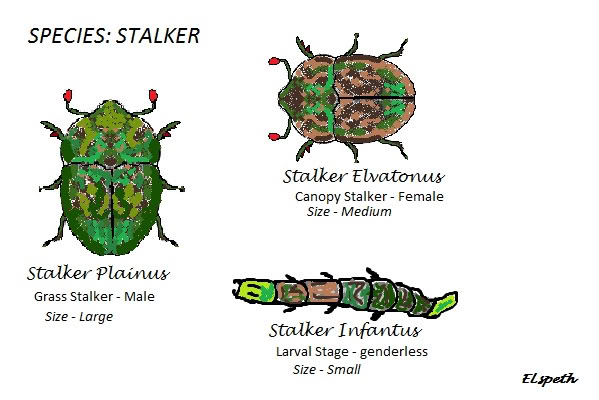|
Stalkers
Although stalker pelts may often be seen for sale in the marketplace, they do not belong
to mammals as might be assumed. Instead the Stalkers are large insects. It is theorized that if their hides
were pure chitin, they would collapse under the weight or they would move too slowly to pursue their prey.
Like all insects they have six limbs though the upper set bears serrated edges and appear more used for hunting
than movement.
As is, their hide is a mix of pelt and reinforced bony plates. They bound swiftly through their chosen
environment (grass lands and plains or treetops) dropping on unsuspecting prey. They appear to be solo hunters
as not great gathering of either subspecies has been found. From observations, it appears that they strike
first for the head, sometimes partially beheading their prey with the speed and strength of their attack. The
only possible exception to this attack is for reproductive surety (see description below).
While Stalker reproduction is not known for certain, partially eaten corpses have been found near the hunting
areas of both known Valorn subspecies. Investigation shows the abdominal cavity was eaten out first and
apparently from the inside. It is because of this a theory has been put forth that the female of the species
paralyzes its prey and lays eggs. The eggs mature and hatch into larva and grow in the unwilling host. After
enough growth has occurred, the host dies as the larva free themselves and begin their molts. The
Plainus species rapidly outgrows its area and begins the long trek to maturity and the grasslands near
Branishor.
Grass Stalker
In its youthful stage the Plainus species is a brilliant green, the better to conceal itself in the
prairie. As it ages the brilliant green fades in the various molts, and by the time it reaches a larger size
suitable for hunting larger prey the coloration is more suited to the grasslands near Branishor.
Canopy Stalker
Elvationus is smaller than its plains cousin. Perhaps this is due to the dearth of larger prey in the
tree tops where it resides hampering any larger growth. The canopy, by its nature, can only support so many
life forms. Fewer glimpses and observations have been made of this creature. Its mottled green and brown
coloration enables it to hide much more in the canopy, and its swift attack can be devastating. A recent
hypothesis that Elvationus is merely a younger version of Plainus has generated much debate but
little answers.

|
|
